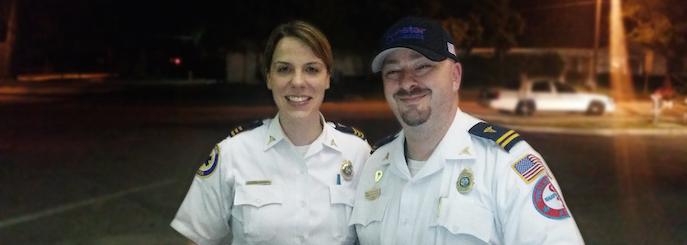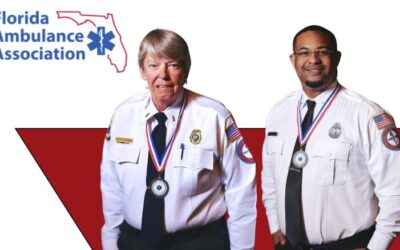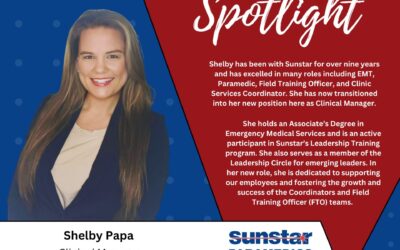Executives from Paramedics Plus, the ambulance service provider for Sunstar Paramedics, knew they needed help to create a new ambulance service from scratch after they won the provider contract in Sioux Falls, South Dakota. Setting up their service a new city required a team that was capable of training employees, organizing supplies and stocking the new ambulances in only two months.
Paramedics Plus saw the successes of Sunstar Paramedics and wanted team members from its Pinellas County operations to help with the start-up of the Sioux Falls operations. Richard Schomp, director of operations at Sunstar, immediately considered operations supervisor Jamie Moon and assistant operations supervisor Mike Townsend for the Sioux Falls team. They had experience as paramedics and knowledge of the equipment, but more importantly, their personalities and management style would help them to connect with the new Paramedics Plus employees. Schomp anticipated that the incumbent staff would feel unsettled by all the changes, and that Townsend and Moon could create stability and help the medics in Sioux Falls make a smooth transition to Paramedics Plus.
Townsend and Moon had moved to Florida together nearly six years ago to work as paramedics for Sunstar Paramedics. When asked to help with the new company, they were excited for the rare opportunity to build the Sioux Falls operation from scratch. They packed their belongings, loaded Jasmine, their zany one-year-old bulldog, into their car and temporarily moved more than 1,600 miles to Sioux Falls.
Townsend and Moon were the only Sunstar employees to temporarily relocate to Sioux Falls, but their co-workers from Sunstar and other employees from East Texas Medical Center, where Paramedics Plus is based, joined them throughout the two-month process.
“We started with nothing. There wasn’t even a building to store the ambulances and supplies,” said Townsend. “Being there from day one gives you a new appreciation for all the hard work that goes into starting a company like this.”
The first step was identifying the supplies needed and how many of each to order. Then, as the supplies arrived, they set up a warehouse and inventory system, and began stocking the ambulances.
Previously, the ambulances had been re-stocked at the hub after returning from a call. Paramedics Plus implemented a system that uses 9-1-1 call history to place ambulances in different areas of the city throughout each shift, which helps reduce the amount of time needed to respond to emergency calls. Sunstar Paramedics also uses this response system.
“Being out in the community during a shift reduces our response time to an emergency,” said Moon. “It also requires that the ambulance be stocked with enough supplies to last a 12-hour shift, which can include multiple calls, without having to return to the hub to restock.”
Since the previous strategy didn’t require ambulances to be stocked for an entire shift, there wasn’t a focus on supply management. Townsend and Moon couldn’t rely on data to order supplies, instead they relied on the Sioux Falls employees to provide anecdotal data to estimate the necessary amount of supplies.
“The current Sioux Falls employees were an integral part of helping us order supplies and stock the new ambulances,” said Moon. “We were fortunate that they were excited to be part of the process and took a lot of pride in preparing their new ambulances.”
 Approximately 40 employees transitioned to Paramedics Plus from the previous ambulance service provider. A 10-hour training program helped the transitioning employees who already had been certified as paramedics to learn the new equipment and technology. Many of those employees came into work on their days off from their previous employer to familiarize themselves with the new trucks and technology, and to help stock supplies.
Approximately 40 employees transitioned to Paramedics Plus from the previous ambulance service provider. A 10-hour training program helped the transitioning employees who already had been certified as paramedics to learn the new equipment and technology. Many of those employees came into work on their days off from their previous employer to familiarize themselves with the new trucks and technology, and to help stock supplies.
The ambulances also needed new technology and equipment. Paramedics Plus equipped the ambulances with portable radios, GPS, software systems and electronic patient care reporting (ePCR) systems to collect data. Much of the technology was new to the Sioux Falls employees.
“At first, we were nervous about how the employees would react to the changes,” said Moon. “But Paramedics Plus showed them that it cares about it employees by asking them for input, constantly communicating about the process and sending employees from all levels of the organization to help. I think that put the Sioux Falls employees at ease.”
Mark Postma, vice-president of Paramedics Plus and COO of Sunstar Paramedics, made frequent trips to Sioux Falls – his hometown – to oversee the process. He even recruited his niece and her friends from nearby Sioux City to help stock the ambulances.
Moon returned to Pinellas County in early May. Townsend stayed to oversee the first few days of service, which began on May 21, 2015, before returning to Pinellas County.
“It was amazing to see the first ambulance leave the station to go into service,” said Townsend.
The team asked a senior crew member, supervisor Jeff Kauffman, to be the first person on the road in Sioux Falls. He had the honor of announcing that Paramedics Plus was in service and available to take emergency calls.
“Our work in Sioux Falls has been an invaluable learning experience,” said Townsend. “We both feel more prepared to pursue management positions and have a deeper understanding and appreciation for the teamwork involved in this business.”




